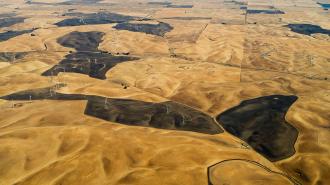In an effort to curb the wildfires that regularly engulf the state, California is now fighting fire with … well, you know.
So far in 2023, only 6,700 acres of Golden State land has burned, but fire season has barely begun — since 2017, the state has been averaging 1.8 million acres burned per year, overwhelmingly concentrated in the back half of the year.
To deal with the rising threats from fire and smoke, the state is sponsoring a program to encourage more prescribed burns and cultural burns. The “Prescribed Fire Liability Claims Fund Pilot” will allocate $20 million to cover losses that may occur if a prescribed or cultural burn ends up slipping control.
Setting fires intentionally may sound like a paradoxical approach to fire control, but if they are done correctly, controlled burns reduce the fuel available for wildfires, helping to prevent the catastrophically large, hot fires that overwhelm firefighting resources. They also are beneficial for a healthy ecosystem.
To deal with the rising threats from fire and smoke, California is sponsoring a program to encourage more prescribed burns and cultural burns.
While they rarely burn out of control, it can happen, and the fear of liability for unintentionally starting a wildfire is one key reason holding back more prescribed burns.
“The Prescribed Fire Claims Fund pilot project removes a significant barrier to obtaining insurance for potential damages from a prescribed fire or cultural burn conducted by a certified prescribed fire burn boss or a cultural fire practitioner,” said Joe Taylor, the director and chief of CAL FIRE, the state’s fire protection agency.
According to the California Wildfire & Forest Resilience Task Force, the fund’s purpose will be twofold: providing coverage to encourage prescribed burns, and demonstrating that prescribed and cultural burns are low risk, so private insurance companies will enter the market.
The overall goal: more controlled burns.
Why burn on purpose? It admittedly seems counterintuitive — or even dangerous — but purposeful burns have been used by Indigenous people to keep forests and wildland healthy for millenia.
Thanks to centuries of overzealous fire protection and the suppression of Indigenous cultural burns — which Europeans found “primitive” — forests have become overgrown, accumulating piles of underbrush and fallen trees. In trying to prevent wildfires altogether, we’ve been essentially storing up bigger and bigger piles of fuel. And with that extra fuel comes fires that burn more ferociously, exacerbated by drought and drier conditions from climate change.
“When you talk to different native people from the Yosemite area, they talk about how it used to look when fire was used as a management tool,” UC Davis professor of Native American Studies Beth Rose Middleton Manning said in a University of California article. Areas that were once open valleys are now choked with conifers and other fuel sources that were not there when cultural burns helped groom the land.
Setting fires intentionally may sound unusual, but if done correctly they reduce the fuel available for wildfires and are beneficial for a healthy ecosystem.
In addition to devouring fuel on purpose, cultural burns especially were aimed at helping promote ecological health and biodiversity. As well as clearing out diseased trees, regular fires help keep trees from overrunning other ecosystems. (If that seems odd, here’s an East Coast example: the Venus fly trap, native of the Carolinas, needs a ton of sun and relies on fire burning away some competition to get it.)
The suppression of prescribed and cultural burns has made California’s forests twice as dense, the Honorable Ron W. Goode, Tribal Chairman of the North Fork Mono Tribe, told UC. When purposeful burns were being used, a variety of plants were able to grow; now, tall trees, which spread fire rapidly when their crowns catch, dominate.
Prescribed burns vs. cultural burns: While both types of burns help control wildfires, there is a difference between prescribed burns — like the kind used by forest services — and cultural burns. Prescribed burns are generally focused mainly on acreage and reducing the amount of fuel available for wildfires; cultural burns are focused on what needs burned to revitalize woodlands and promote biodiversity.
“Cultural burning comes back to what we are burning for, and it’s not burning for acres,” Goode said. “We’re burning to restore the land, restore the resources, restore water. Bring it back to where it can reproduce on its own.”
Both will now be officially encouraged, although to regain their important roles will require eventually spinning up a larger insurance market.
“It’s a tool that has been used for millennia by Native American tribes and one that will continue to play a big role in wildfire prevention,” state senator Bill Dodd, who wrote the bill establishing the fund, said. “The rollout of this fund is a big step toward keeping California communities safe.”
We’d love to hear from you! If you have a comment about this article or if you have a tip for a future Freethink story, please email us at [email protected].






